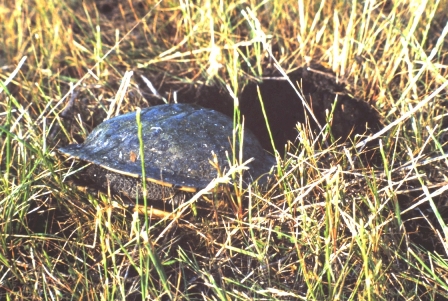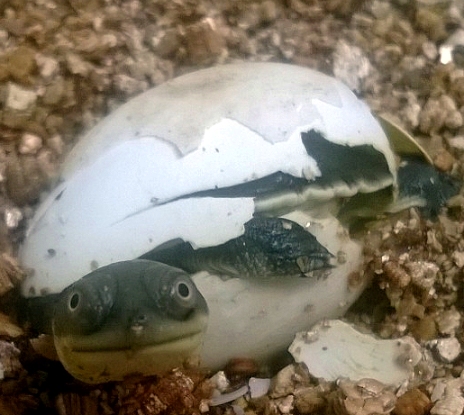| Of the 3 species of priority (at present) in this turtle project, all are aquatic and must lay their eggs in nests on land. The females emerge to dig their nest, most commonly in or just after rainy weather at the right time of the year for the species. They may actually come out and walk around on land several time in the two weeks leading up to actually nesting. How the females determine exactly where to nest is not known, but generally speaking they avoid dense vegetation where the nest would be shaded. |
 |
Turtles have a very characteristic method of nesting. The nest chamber is dug using the back legs, so the female cannot see what she is doing. If she hits an obstruction e.g. a rock or root, she will abandon the nest and try somewhere else. You will often see these abandoned nesting attempts. Record them and try to identify why they were abandoned.
The nesting female digs down with one foot, removing a foot full of dirt and placing beside the nest hole, and then she repeats that action with the opposite foot and so on until she has dug a hole as deep as she can reach. As she gets towards the bottom of the nest, she may raise the front of her body up on her front legs to get better reach into the hole with her back legs. Hence, the depth of the nest is determined by the length of her back legs. Once the hole is deep enough, she digs backwards at the bottom of the hole to end up with a boot-shaped nest chamber.
She then lays eggs into the hole. They drop into each other, sometimes causing small indentation fractures as they crash together. If the eggshell and it underlying membranes are not breached, however, the egg remains viable. The boot-shaped nature of the nest chamber allows eggs to roll backwards into the nest.
| Once all eggs are laid, the female begins to refill the hole with her back legs, dropping soil onto the eggs. The shape of the hole means that often there is an air space left above the eggs in the “foot” or the boot-shaped hole. Once the hole is filled, forming what is called a nest plug, she positions herself over the completed nest, stretches her legs out fully, and then pulls them out from under her body so that her plastron bangs down on the nest. She repeats these body slams several times so that the nest becomes disguised. |
 |
A completed nest is remarkably cryptic, but is often detectable because bits of grass and other vegetation are sticking out of the nest plug in a way that does not look “normal”. A female on the way back to the water will have mud on the posterior of her plastron.